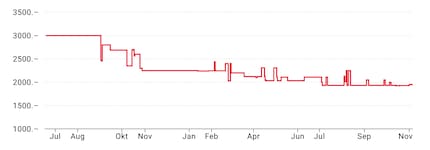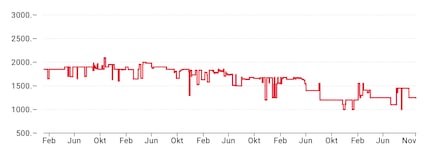
Background information
Why are cameras getting more and more expensive?
by David Lee

Camera prices often make people’s hair stand on end. Didn’t it used to be so much cheaper to buy one? In a bid to find out, I took a look at the latest figures.
Are cameras getting more expensive? If so, why? I had a go at answering these questions in 2021. Long story short, I concluded that yes, camera prices were ticking upwards. Mostly because people tend to buy high-end models over simple ones. When I compared cameras of the same type, however, I found prices had barely increased.
Four years have gone by since that article was published, bringing multiple new cameras onto the scene. With this in mind, it’s time to take another look at the numbers. Has anything changed? Have any new price trends emerged?
Before it disbanded in 2024, the German «Photoindustrie-Verband» (Association of Photographers) published figures on average camera prices. In 2023, the average price of a camera was reportedly 7.2 per cent higher than in 2022. This was in line with the figures mentioned in my previous article. However, the organisation also reported that prices had fallen slightly in individual categories such as SLR and system cameras (article in German). The increase in average prices across all categories was down to the fact that manufacturers were selling more pricey system cameras than budget-friendly compact and SLR cameras. In other words, a continuation of a trend that had been observable for many years. On the whole, cameras were getting more expensive, but mostly because the proportion of pricier models was contributing more to total sales.
The Japanese industry association CIPA (Camera & Imaging Products Association) also publishes figures that can be used to calculate average prices. These point in the same direction, indicating that with the exception of 2019, average camera prices have been rising since 2012. By contrast, the average price of cameras with interchangeable lenses fell continuously until 2019, and has been rising ever since.
The CIPA figures represent prices for retailers, not end customers. They’re also given in yen, so they’re subject to exchange rate fluctuations. What’s more, they include important sales markets such as China, which are driven by very different influences than the likes of Germany and Switzerland. As a result, you can’t use these numbers to draw any conclusions about prices for end customers in Europe. That being said, they’re important to consider when trying to understand the position of the camera industry as a whole.
The same goes for the number of cameras sold. When I looked at the number of cameras shipped worldwide each year since 2012, it was evident there’d been a massive collapse. More than 12 times as many cameras were sold globally in 2012 as in 2023, and there’s an obvious reason why. These days, smartphones take photos good enough to convince people they no longer need to buy an actual camera.
Recent years have shown signs of a slight recovery. Between 2020 and 2023, there was a moderate decrease in unit sales, whereas in 2024, sales actually rose for the first time since the smartphone revolution. This upward trend’s likely to continue for the rest of 2025. With the exception of August, unit sales have been higher than in 2024 in every month of this year so far.
If we consider the number of cameras with interchangeable lenses alone, sales have been rising since 2021. However, that increase is much less significant than the slump that took place in the years prior.
Smartphones have impacted sales of straightforward compact cameras more than expensive system cameras. As a result, manufacturers are focusing their development efforts on high-end products. This is where margins are highest and competition from smartphones is at its lowest.
At the same time, unit sales have fallen for all camera types – another very likely reason behind rising prices. Since the price of electronic components depends heavily on the quantity produced, the slump in camera sales means that development and production costs per unit have risen for manufacturers.
To make matters worse, cameras consist of many highly specialist components, with each manufacturer doing its own thing. Some, for example, make their own processors. In other words, manufacturers are using sensors, processors and autofocus systems for as long as possible in as many models as possible. Newly developed components built into flagship cameras will be added to cheaper cameras later on. Alternatively, older models will continue to be produced and sold at lower prices over time.
What price trends emerge when similar cameras are compared? A new camera model relative to its predecessors, for example?
Let’s take Canon’s EOS R5, a camera aimed at professionals. The R5 is the mirrorless counterpart to the older 5D SLR camera, so it’s fair to compare their prices.
In Switzerland, that line has always been priced at around 4,000 francs, with only the first R5 fetching a slightly higher price of 4,479 francs. Things are very different in Germany, where prices have risen continuously. In fact, they’re now almost twice as high as they were in 2008.
When it comes to the cheaper EOS R6, it’s a similar story in Switzerland. Prices have always hovered around the 2,500-franc mark, with only the 6D Mark II fetching significantly cheaper prices. In Germany, the switch from SLR to mirrorless systems led to a sharp price rise. Apart from that, prices have remained stable.
Looking at Sony’s competitor model, it’s a different story. Every new Sony Alpha 7 released so far has been significantly more expensive than its predecessor, revealing a clear trend towards ever higher prices. The phenomenon applies to both Switzerland and Germany, and can be observed in relation to other Sony cameras too.
The price of the Fujifilm X100 has increased very slightly in Switzerland. Although price changes have been starker in Germany, they’re still moderate. I haven’t found any more information on the first two models for Switzerland.
After several years of very low inflation, prices began rising across Europe in 2021. In Switzerland, however, inflation rates were moderate. According to the Federal Statistical Office, consumer prices have been on the rise since 2022, albeit only slightly. Germany has generally experienced slightly higher inflation, including a more dramatic spike in 2022. However, it’s remained below three per cent since 2024.
At first glance, all of this seems to make sense. Inflation’s been higher in Germany, so camera prices have risen more sharply. On closer inspection, however, that’s not quite the case. Prices didn’t rise the most when inflation was at its highest. Not only that, but the differences between various models and brands don’t match the trend. On the whole, inflation has probably had a minor influence on price fluctuations. When comparing prices in Germany and Switzerland, you’ve also got to bear in mind that the euro has depreciated sharply against the Swiss franc since the mid-noughties.
The prices mentioned above are recommended retail prices (RRP). They’re literally the sales prices recommended to retailers by camera manufacturers. RRP serves as an initial reference point when a product has been announced but isn’t yet available.
The thing is, you can’t draw direct conclusions about real market prices from an RRP. Sometimes, the average market price is well below the RRP shortly after a product goes on sale. After a few years, this is almost always the case.
So, when comparing prices, you have to compare the RRP of both models at market launch or the market prices. However, when a new model’s released, its RRP’s often compared with the old camera’s current market price. These comparisons always create the impression that prices are rising, even if that’s not the case.
This graph compares some cameras’ RRP with their selling price on Galaxus one year after launch.
Sony’s street price was significantly below the manufacturer’s recommendation, but still higher than that of the previous model. The selling price of most of the cameras from other brands actually matched the RRP.
On the whole, the figures paint a mixed picture. Which is unsurprising when you consider that countless factors influence market prices – availability, the retailer’s purchase price, availability of predecessor models, age of the previous generation, level of improvement between previous and current models, and competing models’ prices. Nikon, for example, set an RRP of 3,000 Swiss francs for its Z6III. Given you could get a Nikon Z8 for slightly more and a Canon R6 II for much less, this was clearly too high a price. As a result, the market price fell to just over 2,000 francs within a year. Fujifilm, by contrast, was largely unrivalled when it released the X100VI (which also had limited availability). Consequently, the market price was still on a par with the RRP a year later.

The street prices of cameras that have been on the market for several years sometimes fall drastically. Take the Sony Alpha 7 III, for example. Having launched with an original RRP of 2,599 francs, it’s since been up for grabs for under 1,000 francs on several occasions. The funny thing is, unless you want a camera for video, sports photography or wildlife photography, you could go for an older model without experiencing any major limitations. The general image quality of sensors has barely improved over the past five years.

Thanks to smartphones, cameras have evolved from being everyday, mass-market objects to being both specialised tools for discerning photographers and collector’s items. This considered, it’s little wonder that the average price per camera has risen.
That’s been the case for several years now. Today, at the end of 2025, the camera industry doesn’t look much different than it did in 2021. Sales have stabilised at a low level, even slightly increasing recently. However, that doesn’t change the fact that cameras are a tiny market compared to smartphones, meaning producing them is more expensive. But that hasn’t always been the case. Before the rise of smartphones, digital cameras were a booming mass market.
If you look at prices of the same type of camera, price trends look very different depending on the country and model. In fact, some prices haven’t changed at all. Sony’s a bit of an outlier in this regard. For many years, the company’s consistently been making every new model more expensive than its predecessor. However, Sony’s also kept previous cameras in its range, meaning you can still buy them at relatively low prices. In many scenarios, these slightly less recent cameras are more than sufficient.
My interest in IT and writing landed me in tech journalism early on (2000). I want to know how we can use technology without being used. Outside of the office, I’m a keen musician who makes up for lacking talent with excessive enthusiasm.
Interesting facts about products, behind-the-scenes looks at manufacturers and deep-dives on interesting people.
Show all
Background information
by Samuel Buchmann

Background information
by Michael Restin

Background information
by Ann-Kathrin Schäfer